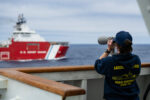Italian shipbuilding giant Fincantieri has signed a Memorandum of Understanding (MOU) with Aeronautical Service S.p.A., aiming to integrate unmanned aerial vehicles (UAVs) into naval platforms. The partnership signals a strategic move beyond traditional steel-centric shipbuilding toward digitalized, networked maritime warfare. The agreement aligns with broader trends in NATO navies seeking to enhance ISR and multi-domain capabilities through organic UAV deployment aboard surface vessels.
Strategic Shift Toward Digital-First Naval Architecture
The Fincantieri–Aeronautical Service MOU is framed as a “step beyond steel,” reflecting the evolution of naval platforms from purely mechanical constructs into integrated systems-of-systems. According to Fincantieri’s official statement on April 18, 2024, the collaboration aims to develop dual-use technologies that fuse manned and unmanned operational domains. This includes integrating fixed-wing and rotary-wing UAVs for intelligence, surveillance, reconnaissance (ISR), targeting support, and potentially logistics roles aboard future surface combatants.
The move is consistent with Italy’s broader defense modernization strategy under the Piano Nazionale della Ricerca Militare (PNRM), which prioritizes unmanned systems and digital C4ISR capabilities. It also reflects NATO’s push for interoperability through STANAG-aligned data links such as Link-16 or future software-defined radio networks that can accommodate drone telemetry alongside traditional comms.
Capabilities of Aeronautical Service’s UAV Portfolio
Aeronautical Service S.p.A., based in Sardinia, specializes in design and operation of fixed-wing drones for both civil and military applications. While not a household name internationally, the company has developed several medium-range tactical UAVs optimized for maritime surveillance missions. Notably:
- AS-100: A modular fixed-wing drone with up to 8-hour endurance; capable of EO/IR payload integration; designed for coastal surveillance.
- AS-Ranger: A tactical VTOL-capable platform under development aimed at shipborne ISR operations; features autonomous landing on moving platforms.
- Ground Control Integration: The company also develops proprietary GCS software compatible with NATO-standard interfaces.
The MOU suggests these systems—or their derivatives—could be adapted for operation from Fincantieri-built vessels such as PPA-class offshore patrol vessels or FREMM frigates. The goal is likely to enable organic ISR capability without relying solely on helicopter assets or satellite cueing.
Implications for Italian Naval Programs
This partnership could have direct implications for several ongoing Italian Navy programs:
- Pattugliatori Polivalenti d’Altura (PPA): These modular OPVs are already designed with open architecture combat systems. Adding drone launch/recovery modules would enhance their situational awareness radius without increasing crew size.
- LHD Trieste: As Italy’s largest amphibious assault ship commissioned in July 2023, Trieste could benefit from swarming drone operations for littoral ISR or electronic warfare missions during amphibious landings.
- Future Submarine Programs: While not explicitly stated in the MOU, underwater-launched aerial drones are an emerging area where this partnership could evolve if vertical launch tubes are adapted accordingly.
The integration of UAVs aligns with Italy’s participation in European defense initiatives such as PESCO’s Integrated Unmanned Ground System (iUGS) and may serve as a testbed for cross-domain interoperability experiments under EU/NATO umbrellas.
C4ISR Integration Challenges and Opportunities
A key technical challenge will be seamless integration of UAV telemetry into existing shipboard combat management systems (CMS). Fincantieri has experience working with Leonardo’s Athena CMS suite used across several Italian Navy ships. Ensuring that drone-derived data—EO/IR video feeds, SIGINT packets or radar tracks—can be fused into the CMS without latency will require robust middleware solutions.
This opens opportunities for embedded AI-based sensor fusion engines capable of real-time threat classification onboard ships. Additionally, deploying drones from vessels introduces challenges around electromagnetic interference (EMI), deck handling logistics during sea state variations, and secure SATCOM/BLOS datalinks—all areas where further R&D investment will be necessary post-MOU phase.
Industrial Strategy and Export Potential
The agreement also positions both companies strategically within the European defense industrial base. Fincantieri already exports warships globally—including FREMM frigates to Egypt—and integrating indigenous UAV solutions could enhance its competitiveness against rivals like Damen or Naval Group who have begun similar integrations (e.g., Airbus VSR700 on French Navy vessels).
Aeronautical Service stands to benefit from access to naval customers it previously lacked exposure to. If successful trials occur within the Italian fleet by late this decade—as expected—the companies may jointly pitch integrated packages abroad under EDA or FMF frameworks targeting navies seeking cost-effective ISR enhancements without full-scale aviation detachments onboard.









